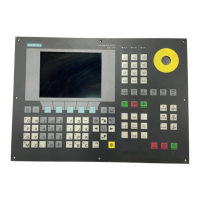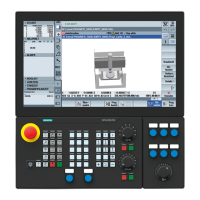Axis couplings
9.2 Curve tables (CTAB)
Job planning
Programming Manual, 07/2010, 6FC5398-2BP40-0BA0
505
Program code Comments
N140 X150 Y6
4th intermediate point:
Master value: 100…150, Following value: 6 to 6
N150 X180 Y0
5th intermediate point:
Master value: 150…180, Following value: 6 to 0
N200 CTABEND
End of definition. The curve table is generated in its
internal representation as a polynomial of up to the 5th
order. The calculation of the curve definition with the
specified intermediate points is dependent on the modally
selected interpolation type (circular, linear, spline
interpolation). The part program state before starting
the definition is restored.
Example 3: Definition of a periodic curve table
Definition of a periodic curve table with number 2, master value range 0 to 360, following
axis motion from 0 to 45 and back to 0:
Program code Comments
N10 DEF REAL DEPPOS
N20 DEF REAL GRADIENT
N30 CTABDEF(Y,X,2,1)
Start of definition
N40 G1 X=0 Y=0
N50 POLY
N60 PO[X]=(45.0)
N70 PO[X]=(90.0) PO[Y]=(45.0,135.0,-90)
N80 PO[X]=(270.0)
N90 PO[X]=(315.0) PO[Y]=(0.0,-135.0,90)
N100 PO[X]=(360.0)
N110 CTABEND
End of definition
;Test of the curve by coupling Y to X:
N120 G1 F1000 X0
N130 LEADON(Y,X,2)
N140 X360
N150 X0
N160 LEADOF(Y,X)
N170 DEPPOS=CTAB(75.0,2,GRADIENT)
Read the table function for master
value 75.0.
N180 G0 X75 Y=DEPPOS
Positioning leading and following
axes.
;After activating the coupling, no synchronization of the following axis is
required.
N190 LEADON(Y,X,2)
N200 G1 X110 F1000
N210 LEADOF(Y,X)
N220 M30

